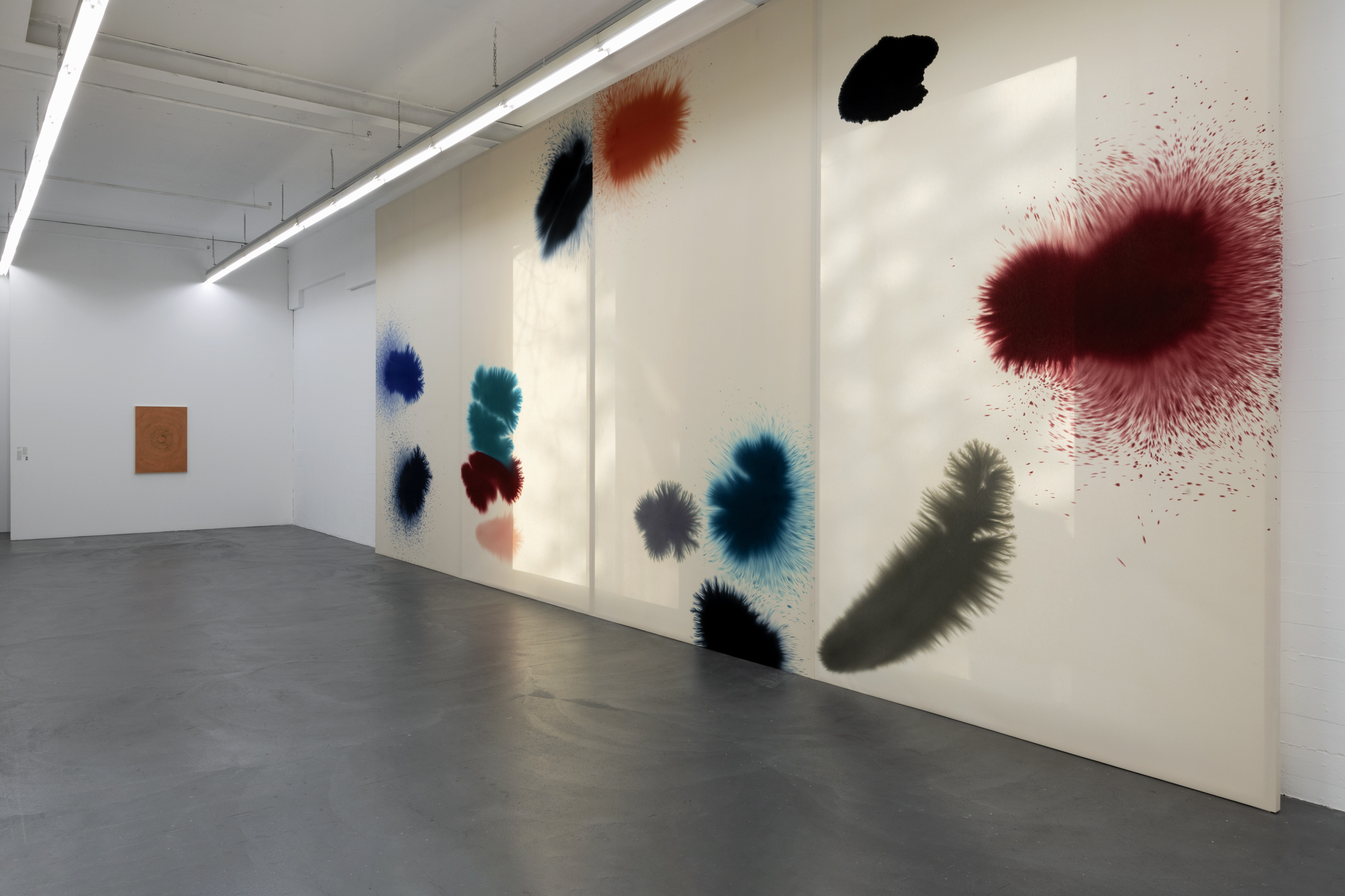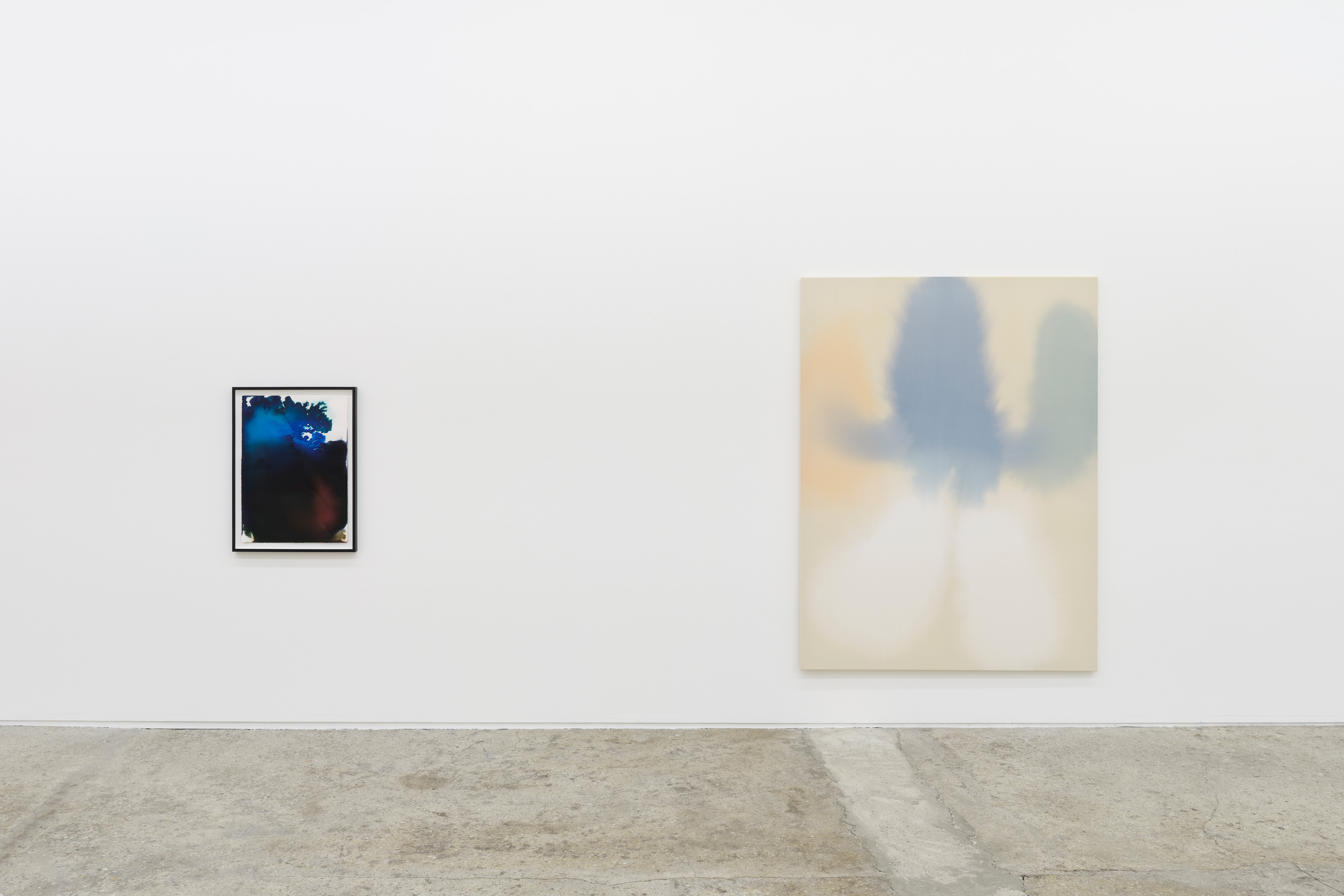2023
Concerto Finale, Regionale
Group show
Kunsthaus Baselland
Kunsthaus Baselland
Nov 26 – Jan 8, 2024
Basel
Basel






Die Bildsprache von Giacomo Santiago Rogado ist frei von raumzeitlichen Koordinaten und erkennbaren Objekten. Seine Werke, meist installativ realisierte Gemälde, zeigen evokative Formen, die als Partikel, Flüssigkeiten, elementare Lebensformen oder Planeten, Sterne oder Galaxien erscheinen. Es entsteht ein Gefühl von Widersprüchlichkeit und Transparenz, von Durchdringung und Überschneidung, von Konsonanz und Resonanz.
«Das Überflüssige weglassen, um das Wesentliche zu finden» – das ist das poetische Credo, das Rogado uns vor Augen führt. Analog dazu tut Rogado beim Malen nichts anderes als «einfach nur malen». Es gibt keine Vorüberlegungen, kein Projekt und kein vorgefertigtes Wissen, die Praxis wird mit Ausgeglichenheit und Ausdauer als eine paradoxerweise blinde Übung des Malens ausgeführt. In seinem Werk Room for Intuitionüberträgt er den Akt des Malens in Teilen auf dieMaterialien seiner Arbeiten. Es handelt sich um eigenständige Arbeiten, in denen sich seine selbst entwickelten Techniken vermischen und neuartige
«Das Überflüssige weglassen, um das Wesentliche zu finden» – das ist das poetische Credo, das Rogado uns vor Augen führt. Analog dazu tut Rogado beim Malen nichts anderes als «einfach nur malen». Es gibt keine Vorüberlegungen, kein Projekt und kein vorgefertigtes Wissen, die Praxis wird mit Ausgeglichenheit und Ausdauer als eine paradoxerweise blinde Übung des Malens ausgeführt. In seinem Werk Room for Intuitionüberträgt er den Akt des Malens in Teilen auf dieMaterialien seiner Arbeiten. Es handelt sich um eigenständige Arbeiten, in denen sich seine selbst entwickelten Techniken vermischen und neuartige
Malereikombinationen generieren. Die mit Farbbädern in einem Zusammenspiel von Zufall und Komposition geschaffenen Werke beeindrucken durch ihre unmittelbare Wirkung. Die Baumwolltücher saugen in einem langsamen Trocknungsprozess die Farben auf, die der Künstler in Behälter hineintröpfelt. Die Tropfen blühen auf den Stoffen zu prächtigen bunten Formen aus. Das Arbeiten ist ein Dialog zwischen Impulsgeben, Beobachten, Entstehen und Reagieren.
Giacomo Santiago Rogado geht bei seinen Arbeiten äusserst einfühlsam mit Licht und Raum um. Dieses Interesse spiegelt sich nicht nur in seinen Gemälden, sondern auch in deren reflektierten Platzierung. Affektiv, mediativ, kontemplativ – so lässt sich das Betrachten mit dem Werk von Giacomo Rogado beschreiben, und es ist zugleich ein Erfassen des eigenen Seins im Raum.
Meryl Kureekal
Giacomo Santiago Rogado geht bei seinen Arbeiten äusserst einfühlsam mit Licht und Raum um. Dieses Interesse spiegelt sich nicht nur in seinen Gemälden, sondern auch in deren reflektierten Platzierung. Affektiv, mediativ, kontemplativ – so lässt sich das Betrachten mit dem Werk von Giacomo Rogado beschreiben, und es ist zugleich ein Erfassen des eigenen Seins im Raum.
Meryl Kureekal
2023
connecting
Solo show
Galerie Mark Müller
Galerie Mark Müller
20/1/23 – 18/3/23
Zürich
Zürich












What a paradox to call an exhibition of abstract painting connecting, when the Latin root of the word ‘abstraction’ speaks of detachment. This apparent contradiction is even more striking if we consider that the works chosen by Giacomo Santiago Rogado for the Mark Müller Gallery belong to different series and are thus dis- connected from their original contexts.
Yet, it is precisely in these cognitive dissonances that the true meaning of the exhibition lies. Only here, in the distances and discrepancies between the artworks on display, we are able to appreciate the poetics that connect Rogado's extensive research. Here the artist unfurls his very own understanding of ‘abstraction’ as an intimate connection with the audience, a dialogue with the other, without ever imposing but proposing, never affirming but always questioning.
The visual language of connecting is devoid of spatio-temporal coordinates and recognisable objects. The works depict evocative shapes that appear as particles, fluids, elementary life forms, or planets, stars, galaxies. In these compositions, fantasies of extraordinarily small and extraordinarily large worlds converge to express fundamental properties. We thus perceive a sense of inconsistency and transparency, interpenetration and overlap, consonance and resonance.
Rogado's reduced and sophisticated style offers a welcome alternative to the visual saturation of our time. As we follow the delicate
Yet, it is precisely in these cognitive dissonances that the true meaning of the exhibition lies. Only here, in the distances and discrepancies between the artworks on display, we are able to appreciate the poetics that connect Rogado's extensive research. Here the artist unfurls his very own understanding of ‘abstraction’ as an intimate connection with the audience, a dialogue with the other, without ever imposing but proposing, never affirming but always questioning.
The visual language of connecting is devoid of spatio-temporal coordinates and recognisable objects. The works depict evocative shapes that appear as particles, fluids, elementary life forms, or planets, stars, galaxies. In these compositions, fantasies of extraordinarily small and extraordinarily large worlds converge to express fundamental properties. We thus perceive a sense of inconsistency and transparency, interpenetration and overlap, consonance and resonance.
Rogado's reduced and sophisticated style offers a welcome alternative to the visual saturation of our time. As we follow the delicate
juxtapositions between shapes, the careful layering of colour, and the constant search for depth, matters of virtual realities, high resolution and augmented reality move further into the distance.
Discart the superfluous in order to find the essential – this is the poetic truth that Rogado presents to us. His art’s graceful language reveals a desire to give voice to transcendence, to let it speak, with all its murmurs and silences.
"All this without looking you will see..."
Pablo Neruda once said to his friend. It applies perfectly to Rogado's work as well, aiming right at its most profound meaning. While Rogado has certainly chosen the arduous path of abstraction, exposing himself to the risks of intellectualism, didacticism or insignificance, he wanders along it implementing Neruda's words to his own world of images: How can painting show the invisible?
A paradoxical question to which one can only give paradoxical answers. Rogado, an avid pupil of Zen philosophy, is well aware of this. According to the ZaZen school, meditation can be summarised in one single expression: 'just sitting'. Similarly, while painting Rogado does nothing more than... ́just painting’. There is no forethought, no project, and no pre-constituted knowledge, the practice is carried out with balance and perseverance as a "paradoxically blind exercise of painting".
And what this exercise, above all else, bears witness to is an act of faith in everything we can see only by briefly closing our eyes.
Luca Libertini
Discart the superfluous in order to find the essential – this is the poetic truth that Rogado presents to us. His art’s graceful language reveals a desire to give voice to transcendence, to let it speak, with all its murmurs and silences.
"All this without looking you will see..."
Pablo Neruda once said to his friend. It applies perfectly to Rogado's work as well, aiming right at its most profound meaning. While Rogado has certainly chosen the arduous path of abstraction, exposing himself to the risks of intellectualism, didacticism or insignificance, he wanders along it implementing Neruda's words to his own world of images: How can painting show the invisible?
A paradoxical question to which one can only give paradoxical answers. Rogado, an avid pupil of Zen philosophy, is well aware of this. According to the ZaZen school, meditation can be summarised in one single expression: 'just sitting'. Similarly, while painting Rogado does nothing more than... ́just painting’. There is no forethought, no project, and no pre-constituted knowledge, the practice is carried out with balance and perseverance as a "paradoxically blind exercise of painting".
And what this exercise, above all else, bears witness to is an act of faith in everything we can see only by briefly closing our eyes.
Luca Libertini